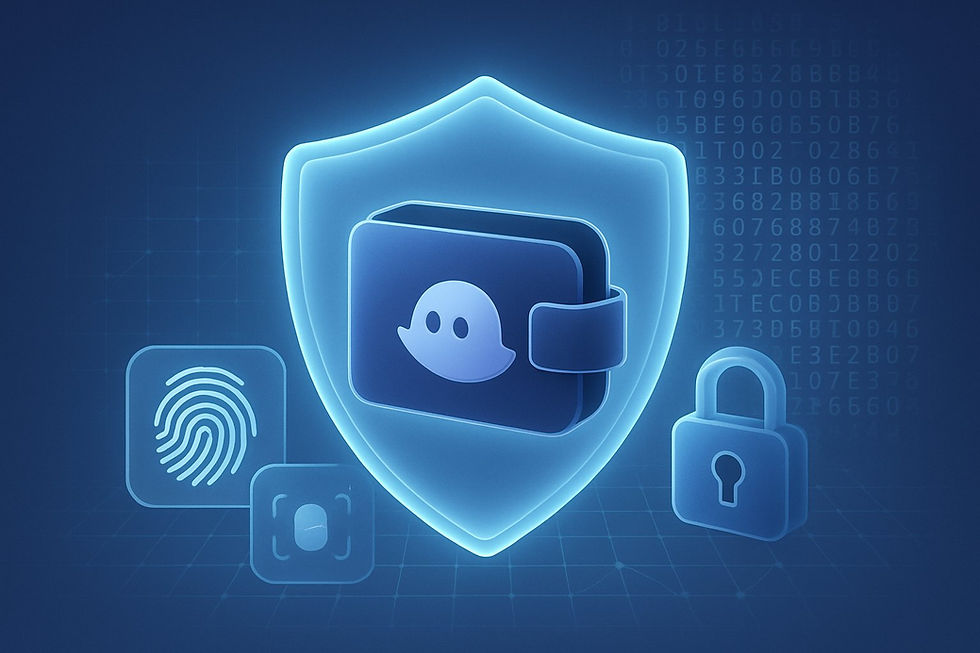Is Phantom Wallet Safe? Security, Features, and Real-World Use
- The Master Sensei

- Sep 13
- 5 min read
Phantom Wallet shot up in popularity after its 2021 launch, especially with Solana fans. With more than 15 million people trusting it to hold their crypto, it’s no surprise folks are asking: is Phantom actually safe? Phantom Wallet gets high marks for safety thanks to features like local encryption, scam detection, and hardware wallet support. Still, it’s a software wallet, so it’s not totally free from online risks.

They’ve built in advanced protection, including scam filters, and security audits from respected firms. But Phantom hasn’t dodged every bullet—there have been phishing attacks and some vulnerabilities, with a few users losing funds. These incidents push the team to keep improving security, but let’s be real, any hot wallet will always have some exposure.
So, is Phantom really as safe as people hope? You have to look at its tech, how it’s held up in the wild, and how it fits into the bigger crypto scene. Here’s a closer look at what Phantom does to protect users, the bumps it’s hit along the way, and how it actually feels to use day-to-day with Web3 and DeFi.
Is Phantom Wallet Safe? Core Security Features and Protections
Phantom Wallet layers on security with a non-custodial setup, strong encryption, anti-phishing tools, and options like biometrics and hardware wallets. All these features aim to keep your funds safe without making things a hassle.
Non-Custodial Infrastructure and Private Key Management
Phantom runs as a non-custodial wallet, so you alone control your private keys and funds. The wallet doesn’t store or touch your private keys on any outside servers.
Your private keys stay encrypted, living only on your device. This setup avoids the risks of centralized exchange hacks or third-party leaks.
You have to back up and protect your secret recovery phrase—a 12-word master key that lets you recover your wallet anywhere.
Lose your password or secret phrase and Phantom can’t help you get it back. You need to keep those credentials safe, period.
Encryption, Secret Recovery Phrase, and Local Storage
Phantom relies on the ChaCha20-Poly1305 encryption algorithm for sensitive data. This is military-grade stuff and keeps your private key storage locked down.
They use an audited Shamir Secret Sharing system to split encryption keys across different pieces, which adds another wall between your data and attackers.
Your secret recovery phrase sits inside an encrypted vault. Only you can unlock it with your password or biometrics. That vault doesn’t talk to the internet or anything outside.
All the important data stays on your device, not on Phantom’s servers. This local approach shrinks your exposure to network hacks and leaks.
Phishing, Scam, and Malicious Contract Protections
Phantom bakes in Blowfish-powered detection to flag sketchy contracts before you sign off. It works across Solana, Ethereum, and Polygon.
You’ll see real-time warnings if you’re about to click a fake site or interact with a dodgy dApp. These previews help you dodge phishing and DNS hijacks.
Anti-scam features include:
Spam token and NFT detection using machine learning
An open-source blocklist of 2,000+ malicious domains
Burn NFT feature to delete unwanted NFTs for small SOL rewards
Automatic scam detection through third-party tools
You can hide, report, and burn shady NFTs right inside the wallet. It’s a nice way to keep things tidy and maybe earn a little SOL on the side.
Biometric Authentication and Hardware Wallet Support
Phantom supports Face ID and fingerprint unlock on mobile, so you get quick but secure access.
You can connect Ledger hardware wallets through browser extensions (Chrome, Edge, Brave) and the mobile app—though not Firefox.
Supported hardware wallets include Ledger Nano X and other Ledger devices. This lets you sign transactions offline while managing tokens in Phantom’s interface.
Hardware wallet support means you can keep your private keys cold, but still use Phantom for DeFi and token management.
How Phantom Wallet Performs in Practice and Its Ecosystem Connections
Phantom’s user base has exploded since 2021, and a few security incidents have shaped how the wallet’s evolved. It plugs into major DeFi protocols and NFT marketplaces, competing head-to-head with wallets like MetaMask and Solflare.

User Experiences and Real-World Security Incidents
Phantom’s had some bumps. Back in September 2021, the “Demonic” vulnerability hit multiple browser wallets, including Phantom, and could’ve exposed secret recovery phrases. The team patched it quickly.
In 2022, hackers sent out fake security update links via NFTs, which tried to steal passwords. Phantom answered by launching the burn NFT feature, letting users delete spam NFTs and get some SOL.
The biggest blow came in 2025, when hackers stole $500,000 from creator Liam Murphy’s account. The Wiener Doge token crashed 99%. Legal battles with Phantom Technologies are still unfolding.
Even with these issues, Phantom holds an 85 security score on CertiK Skynet. They use ChaCha20-Poly1305 encryption and Blowfish transaction previews to sniff out malicious contracts on Solana, Ethereum, and Polygon.
Supported Networks, Tokens, and Decentralized App Integrations
Phantom supports six big networks: Solana, Ethereum, Polygon, Bitcoin, Sui, and Base. You can manage as many tokens as you want—no need to add them by hand.
The built-in dApp browser hooks you up to top DeFi protocols like Uniswap, AAVE, Raydium, and Jupiter. For Bitcoin, you can access Ordinals and BRC-20 tokens via Magic Eden.
Phantom’s Crosschain Swapper lets you transfer tokens across supported networks using LiFi. It taps liquidity from 30+ chains and 38+ DEXs, though you can’t swap Bitcoin yet.
Staking options:
Native SOL staking at 7.55% APY
Liquid staking with JitoSOL (up to 15% APY)
PSOL staking (up to 9% APY)
ETH liquid staking via third-party providers
You can buy crypto with fiat using MoonPay, Coinbase Pay, or Banxa—credit cards, Apple Pay, and PayPal all work.
NFT Gallery and Marketplace Features
Phantom’s NFT gallery shows collections from Solana, Ethereum, and Polygon. The Collectibles section lets you preview images, audio, and video NFTs.
With Instant Sell, Phantom grabs bids from OpenSea, Blur, Magic Eden, Tensor, and LooksRare. You can sell NFTs fast, just by accepting the best offer—no manual listings needed.
There’s support for compressed NFTs (cNFTs) on Solana, which saves space and fees. The burn NFT feature helps you clear out spam or junk NFTs and pick up some SOL.
Their scam filters use machine learning to spot fake tokens and NFTs. You can hide, report, or burn anything suspicious right from the wallet.
Comparison to Other Crypto Wallets
Phantom goes head-to-head with MetaMask as a top Web3 wallet, earning its reputation as "the MetaMask of Solana." While MetaMask sticks with Ethereum, Phantom leans hard into the Solana ecosystem but still manages to handle multiple chains.
Key differences from competitors:

Phantom shines with Solana-specific perks like native staking, compressed NFT support, and a Solana-only mode. Trust Wallet covers more networks, but honestly, it just doesn't go as deep into DeFi as Phantom does.
You’ll find Phantom’s mobile app and browser extension work pretty much the same, no matter where you use them. Right now, hardware wallet support sticks to Ledger devices, and only through Chrome, Edge, or Brave.
















































Comments